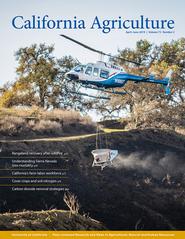All Issues

UC Cooperative Extension research indicates that seeding for forage production may be advantageous on badly burned land. In January 2018, 1,000 acres on this Ventura County ranch were aerially seeded with 10,000 pounds of cereal rye in 1 day. Photo by Monica Karl.
University of California Cooperative Extension specialists Van Butsic and Ted Grantham discuss cannabis research featured in a special issue of California Agriculture journal.
Volume 73, Number 2
News and opinion
A free hay program was started after the Thomas fire, closed highways were opened for ranchers after the Camp fire, and UC research helped answer ranchers' questions about pasture recovery.
Critical research and dialogue are underway to understand the consequences of the massive wave of tree mortality in the Sierra Nevada.
Through cooperative ventures around the state, the UC Master Gardener program brings horticultural knowledge to Californians in jails, detention centers and treatment facilities.
Recent articles from the Agricultural Experiment Station campuses and UC ANR's county offices, institutes and research and extension centers.
Through technology demonstration and policy engagement, UC ANR specialists, advisors and AES faculty can support California's ambitions to remove CO2 from the atmosphere.





